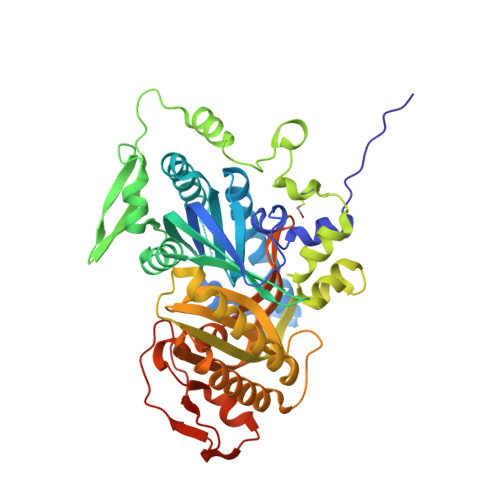Structural Analysis of Human Soluble Adenylyl Cyclase and Crystal Structures of its Nucleotide Complexes -Implications for Cyclase Catalysis and Evolution.
Kleinbolting, S., Van Den Heuvel, J., Steegborn, C.(2014) FEBS J 281: 4151
- PubMed: 25040695
- DOI: https://doi.org/10.1111/febs.12913
- Primary Citation of Related Structures:
4UST, 4USU, 4USV, 4USW - PubMed Abstract:
The ubiquitous second messenger cAMP regulates a wide array of functions, from bacterial transcription to mammalian memory. It is synthesized by six evolutionarily distinct adenylyl cyclase (AC) families. In mammals, there are two AC types: nine transmembrane ACs (tmACs) and one soluble AC (sAC). Both AC types belong to the widespread cyclase class III, which has members in numerous organisms from archaeons to mammals. Class III also contains all known guanylyl cyclases (GCs), which synthesize the cAMP-related messenger cGMP in many eukaryotes and possibly some prokaryotes. Among mammalian ACs, sAC is uniquely regulated by bicarbonate, and has been proposed to be more closely related to a bacterial AC subfamily than to mammalian ACs, on the basis of sequence comparisons. Here, we used crystal structures of human sAC catalytic domains to analyze its relationships with other class III ACs and GCs, and to study its substrate selection mechanisms. Structural comparisons revealed a similarity within an sAC-like subfamily but no family-specific structure elements, and an unexpected sAC similarity to eukaryotic GCs and a potential bacterial GC. We further solved novel crystal structures of sAC catalytic domains in complex with a substrate analog, unprocessed ATP substrate, and product after soaking with ATP or GTP. The structures show a novel ATP-binding conformation, and suggest mechanisms for substrate association and recognition. Our results could explain the limited substrate specificity of sAC, suggest how specificity is increased in other cyclases, and indicate evolutionary relationships among class III enzymes, with sAC being close to a putative 'ancestor' cyclase. Coordinates and structure factors for the novel sAC-cat structures described have been deposited with the Worldwide PDB (www.pdb.org): ApCpp soak (entry 4usu), ATP + Ca(2+) soak (entry 4usv), GTP + Mg(2+) soak (entry 4ust), ATP soak (entry 4usw).
Organizational Affiliation:
Department of Biochemistry, University of Bayreuth, Germany.





















